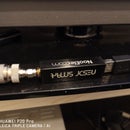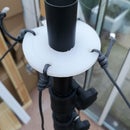Introduction: Vacuum Tube Lamp
I made this simple lamp in an afternoon using an old (read blown) valve since I have more than a few lying around. It's made from CLS construction grade pine timber and powered via USB.
Step 1: Tools & Materials
Materials
- 50mm X 50mm CLS Timber
- 3mm LED
- 100 Ohm 1/4W resistor
- 2-core cable (20C/28D AWG)
- USB Connector
- Clear Silicon Sealent
Tools
- Mitre Block & Wood Saw (or a compound saw)
- Sandpaper (100 - 400 git)
- 5mm Drill bit
- 20mm Spade bit
- Drill (Cordless or Wired)
- Paint Brush
- Wood Stain
- Furniture Wax
- Soldering Iron & Solder
Step 2: Construction
Electrical
The circuit is very simple, comprising of a single 3mm (5mm is also fine) and a suitable resistor. For my lamp I used I a 3mm blue LED which has a forward voltage of 3.1v and a typical current draw of 20mA, using Ohms law and knowing the supply voltage (USB in my case) is 5v I was able to calculate the value of the resistor as 100R (Ohms).
There is a really good website that can provide these calaculations otherwise checkout Ohms law on Wikipedia
I attached the resistor to the LED by cutting the anode (the positive lead which is the longest one) down to roughly 5mm, then also cutting one leg of the resistor to 5mm. Solder the these two leads together to form the lamp unit.
Proceed to measure and cut a suitable length of wire, and solder onto the lamp unit. Solder and assemble the USB connector to complete. From experience the USB connector may require a drop of glue to make it hold together properly.
Construction
Start of by measuring a length of timber for the base, I found a suitable length to be just under half of that of the length of the valve, and cut it cleanly using a mitre block of compound mitre saw. Mark off the center of the base and using the 5mm drill bit drill a hole through the entire length of base from the grained ends. Then proceed to drill a larger hole on one end of the using the 20mm spade bit to a depth of roughly 10mm using the previously drilled 5mm hole as a guide. On the other end of the base use a knife to carefully cut a small channel that will allow the wire to pass out of the bottom of the base.
Thoughly sand all surfaces and the inside of the larger hole, using a clean paint brush apply some water to the grain ends and wait for them to dry then proceed to sand further increasing in grit.
Once you are happy with the finish stain or paint the base and once dry apply a light coat of finishing wax to seal.
Finishing
Pass the LED assembly though the hole starting at the bottom of the base, you may need to use a small screwdriver to help it pass through, The head of the LED should sit so that the dome is just visible inside the larger hole. When you are happy with the depth apply a 1-5mm layer of clear silicon into the hole and push the valve into place. Once dried and if applied correctly the silicon should secure the both the valve tube and led adequately. Loop the remaining power lead via the notch created previously and secure with a small amount of glue.





